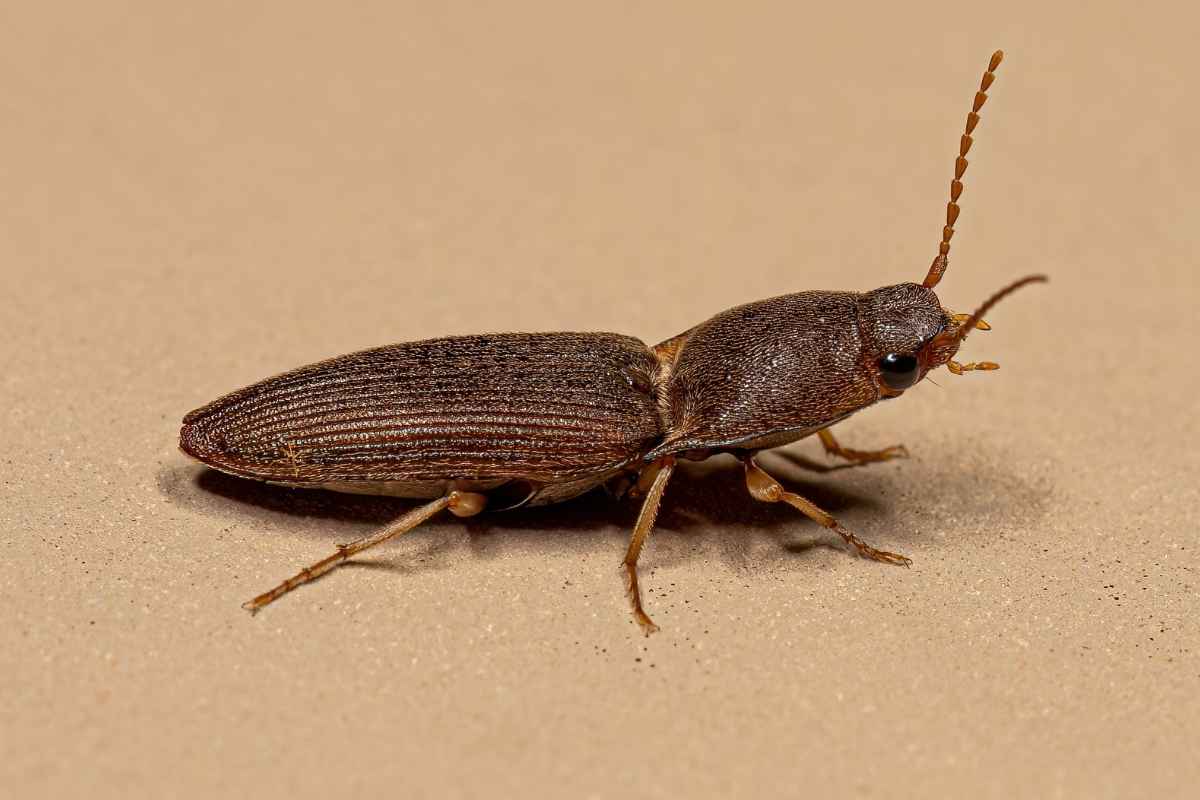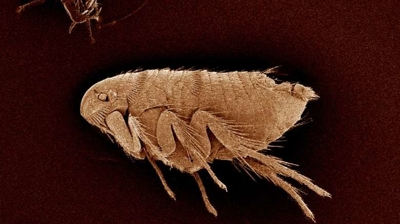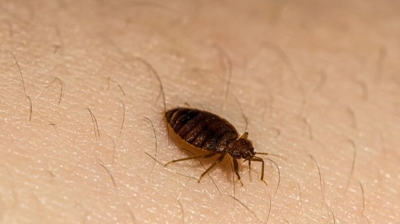
Click Beetles

Are Click Beetles Harmful?
Click beetles themselves are generally not harmful to humans—these beetles don’t bite, sting, or transmit disease—but their larvae, known as wireworms, can cause significant damage, especially in agricultural and garden settings. Here are some of the ways click beetles and their larvae might be considered harmful:
Agricultural Crop Damage
- Wireworms, the larval stage of click beetles, feed on seeds, roots, and underground stems of many crops.
- Commonly affected crops include corn, potatoes, wheat, carrots, and other root vegetables.
- Damage can lead to poor germination, stunted plant growth, and reduced yields.
- In severe infestations, plants may die entirely, which can have a significant economic impact on farmers.
Damage to Turf and Lawns
- Wireworms can infest lawns, golf courses, and turf grass, feeding on grass roots and creating bare patches.
- This weakens the grass, making it more susceptible to disease, drought, and other pests.
Economic Impact
In commercial farming, wireworm infestations can increase costs due to:
- Reduced crop yield
- Need for soil treatments or insecticides
- Replanting expenses if seedlings fail to emerge
Potential Indirect Harm
- By damaging plants, wireworms can make crops more vulnerable to secondary infections by fungi or bacteria.
- They can also attract other pests that feed on weakened plants.
Horticultural and Garden Concerns
- Home gardeners may notice poor germination or holes in root vegetables like carrots and potatoes.
- While not directly dangerous to humans or pets, the damage can be frustrating and affect harvest quality.
The primary harm associated with click beetles comes from their larvae—the wireworms—which are significant agricultural pests affecting crops, turf, and gardens. Adult click beetles themselves are mostly harmless and only a nuisance if found indoors.
Learn more: Do Click Beetles Bite? || What Do Click Beetles Eat?
Click Beetle Removal
Click beetles may seem harmless at first glance, but they pose significant risks, especially in agricultural and horticultural settings, and managing them is important for several reasons:
- Larval Damage (Wireworms): The larvae of click beetles, known as wireworms, are particularly destructive. They live in soil and feed on the roots, seeds, and underground stems of a wide variety of crops, including corn, potatoes, wheat, and vegetables. This feeding can stunt plant growth, reduce yields, and even kill young plants, leading to substantial economic losses.
- Crop Vulnerability: Wireworms often target newly planted seeds and seedlings. Because the damage occurs below ground, it can go unnoticed until it manifests as poor germination or weak, dying plants. Infestations can affect both small-scale farms and large commercial operations, making early detection and management critical.
- Pest Persistence: Click beetles have long lifecycles. Some wireworms can live in the soil for several years before pupating into adults, which makes infestations difficult to eliminate once established. Their presence can affect multiple planting seasons if not controlled.
- Secondary Damage: Plants weakened by wireworm feeding are more susceptible to disease, fungal infections, and other pests. This creates a compounded threat to crop health and further impacts yields.
Effectively controlling click beetles requires integrated pest management: crop rotation, monitoring, proper soil management, and, when necessary, targeted insecticides. Addressing the problem early is far easier and more cost-effective than trying to remediate severe infestations after the fact.
Learn more: How To Get Rid Of Click Beetles
Click Beetle Control
Hiring our professional pest control for click beetles—more accurately, for their larvae, wireworms—is highly advisable because controlling them effectively requires expertise, specialized tools, and preventive strategies. Here’s why our professional intervention is often the best approach:
Accurate Identification
- Many beetles look similar, but only certain species’ larvae (wireworms) are harmful to crops and turf.
- Our professionals can correctly identify both adult click beetles and their larvae, ensuring the treatment targets the right pest and avoids unnecessary pesticide use.
Targeted Treatment
- Wireworms live underground, feeding on roots and seeds. DIY methods often fail to reach them effectively.
- Our professionals use soil treatments, baiting systems, or integrated pest management (IPM) techniques that reach larvae where they live.
- This precision minimizes environmental impact and protects beneficial insects.
Preventing Crop and Turf Damage
- Wireworm infestations can significantly damage gardens, lawns, and commercial crops.
- Our professionals assess risk areas, treat affected soil, and implement preventive strategies to protect current and future planting cycles.
- Early intervention reduces losses in yield, plant health, and overall property aesthetics.
Integrated Pest Management Expertise
Effective click beetle control is rarely about one-time spraying. It typically involves:
- Crop rotation or soil management to reduce larvae populations
- Monitoring traps to detect adult beetle activity
- Targeted chemical or biological controls when necessary
Our professionals can design a long-term, sustainable strategy instead of relying on ineffective DIY solutions.
Safety and Compliance
- Many chemical controls require careful handling to avoid harm to humans, pets, or beneficial organisms.
- Our licensed pest control technicians know proper application rates, timing, and safety precautions.
Cost Efficiency Over Time
- DIY attempts often fail, requiring repeated treatments that can be costly.
- Our professionals provide efficient, lasting solutions that reduce the likelihood of recurring infestations and potential crop or turf loss.
Click beetles themselves are mostly harmless, but their larvae—wireworms—can cause serious agricultural and horticultural damage. Our professional pest control ensures proper identification, effective treatment, long-term prevention, and safety, which is difficult to achieve with DIY methods.
Click Beetle Exterminators
Hiring our local exterminators over a national company for click beetle control offers several practical and strategic advantages:
- Localized Expertise: Click beetle infestations often vary regionally due to soil type, climate, crop patterns, and local ecosystems. Our local exterminators have firsthand experience with the species and behaviors common to the area, allowing for more accurate identification, timing, and targeted treatments.
- Faster Response Time: Our local professionals can typically respond much faster than a national chain, which may require scheduling through a central office and coordinating crews from outside your area. Prompt action is crucial because wireworms (click beetle larvae) can cause significant root damage quickly.
- Customized Solutions: Our local exterminators are more likely to tailor their approach to your specific property or crops. This includes selecting the most effective insecticides, timing treatments to coincide with beetle life cycles, and recommending integrated pest management practices that fit your soil and crop rotation patterns.
- Knowledge of Local Regulations: Pest control regulations, pesticide approvals, and environmental restrictions can vary by state or municipality. Our local professionals are well-versed in these rules, ensuring compliance and minimizing legal or environmental risks.
- Cost Efficiency: National companies often have higher overhead and may push standardized treatments that aren’t optimized for your situation. Our local exterminators can focus on what actually works for your property, potentially reducing unnecessary chemical use and associated costs.
- Ongoing Support: Click beetle infestations often require monitoring over multiple seasons due to the long lifespan of wireworms. Our local exterminators provide continuous, on-site support, track seasonal trends, and adjust strategies as needed, building a relationship that ensures long-term effectiveness.
- Accountability and Reputation: Local businesses rely on word-of-mouth and community reputation. This generally translates to higher service quality, transparency, and responsiveness compared to a distant corporate call center model.
While national companies may offer brand recognition and scale, our local exterminators bring nuanced, region-specific expertise and responsiveness that directly improves the likelihood of successfully eliminating click beetles and preventing recurrent infestations.
Click Beetle Solutions
Our exterminators use Integrated Pest Management (IPM) to control click beetles because their larvae, commonly known as wireworms, can damage crops, turf, and stored products, while adults may be a nuisance around structures. IPM begins with a detailed inspection to identify beetle species, assess infestation levels, and locate breeding or feeding sites, such as soil, mulch, or stored grains. Management strategies combine habitat modification, including crop rotation, removal of decaying plant material, and reduction of soil moisture, with targeted interventions like baits, traps, or localized insecticide applications where necessary. Physical exclusion and proper storage practices prevent beetles from infesting buildings or stored products. Ongoing monitoring allows our exterminators to track activity, evaluate the effectiveness of treatments, and adjust strategies without overusing pesticides. By integrating inspection, preventive measures, precise interventions, and monitoring, IPM provides a long-term, environmentally responsible solution for managing click beetle populations.
What Do Click Beetles Look Like?
Click beetles have a distinctive appearance that makes them recognizable, though their size, color, and markings can vary depending on the species. Here’s a detailed description:
Size
- Typically 6–30 mm (0.25–1.2 inches) long, depending on the species.
- Slender, elongated body shape.
Body Shape
- Narrow, cylindrical or slightly flattened.
- Hard, smooth exoskeleton with well-defined head, thorax, and abdomen.
- Pronotum (the shield-like plate behind the head) is often arched or trapezoidal and may have backward-pointing spines or sharp edges along the sides.
Color
- Usually brown, black, or reddish-brown, though some species have metallic or mottled markings.
- Often fairly uniform in color, which helps them blend into soil, leaf litter, or bark.
Antennae
- Long, thread-like or slightly serrated, usually segmented with 11 segments.
- Positioned on the sides of the head.
Legs
- Six legs, relatively short, suited for crawling.
- Legs are generally not used for jumping; instead, click beetles rely on their unique “click” mechanism for flipping.
Distinctive Click Mechanism
- The underside of the thorax has a spine-and-groove system.
- When threatened or overturned, the beetle can snap this spine into the groove, producing a clicking sound and propelling itself into the air.
This is a hallmark feature distinguishing them from other beetles.
Larval Stage (Wireworms)
- Wireworms are cylindrical, hard-bodied larvae, yellowish-brown, and often 1–5 cm long.
- They live underground and feed on seeds, roots, and underground stems, causing the primary damage associated with click beetles.
Adult click beetles are slender, elongated beetles with a hard exoskeleton, dark brown or black coloring, and a unique clicking ability. Their larvae, wireworms, are pale, segmented, and live in soil, where they cause damage to crops and plants.
Where Are Click Beetles Found?
Click beetles are widespread, but where you encounter them depends on their life stage and species:
Adults
- Vegetation: Most adult click beetles are found on plants, flowers, trees, and shrubs, where they feed on nectar, pollen, or small insects.
- Near lights: Many species are attracted to lights at night, so you may see them around porches, windows, and outdoor lighting.
- Under bark or debris: Some species hide under tree bark, logs, leaf litter, or mulch during the day.
- Gardens and fields: Adults are often present near agricultural fields, lawns, and gardens, since these areas are where they lay eggs.
Larvae (Wireworms)
- Soil: Wireworms live underground, in moist, loose soil, often where there is decaying organic matter.
- Crop fields and gardens: They are most common in corn, potatoes, wheat, and root vegetable fields, feeding on seeds and roots.
- Lawns and turf: Lawns, golf courses, and pastures can harbor wireworms, which feed on grass roots.
- Old or unplowed fields: Areas with long-term grass cover or pastures tend to have higher wireworm populations.
Seasonal Activity
- Spring and summer: Adults are more active during warmer months and are often seen on vegetation.
- Late summer and fall: They lay eggs in the soil, which hatch into wireworms.
- Wireworms: They can live in the soil for 2–5 years depending on species, so infestations may persist even if adult beetles aren’t visible.
You are most likely to encounter adult click beetles on plants, under bark, or near outdoor lights, while their larvae (wireworms), which are the damaging stage, live in soil, gardens, crop fields, and turf. Moist, undisturbed soils with plenty of organic matter are the hotspots for wireworm activity.
Click Beetle Life Cycle
Click beetles have a multi-stage life cycle that can span several years, depending on the species and environmental conditions. The life cycle consists of four stages: egg, larva (wireworm), pupa, and adult. Understanding this cycle is important because the larval stage is the stage that causes significant agricultural and garden damage:
Egg Stage
- Location: Eggs are laid in soil, usually near roots of grasses, crops, or other plants.
- Size and appearance: Small, white or cream-colored, and difficult to see without close inspection.
- Duration: Usually 2–6 weeks, depending on soil temperature and moisture.
Larval Stage (Wireworm)
- Appearance: Cylindrical, hard-bodied, yellowish-brown larvae.
- Feeding habits: Feed underground on seeds, roots, and stems of crops, turf, and garden plants.
- Duration: This is the longest stage, lasting 1–5 years depending on species and environmental conditions.
- Growth: Larvae molt multiple times as they grow, increasing in size with each molt.
Pupal Stage
- Location: Occurs in the soil, often at a slightly deeper level than the larvae.
- Appearance: Non-feeding, inactive stage where the larva transforms into an adult beetle.
- Duration: Usually 1–3 weeks, depending on temperature and moisture conditions.
Adult Stage
- Appearance: Slender, elongated beetle with a hard exoskeleton and the characteristic click mechanism.
- Feeding: Adults feed lightly on nectar, pollen, or small insects; they do not typically damage plants significantly.
- Reproduction: Adults mate soon after emerging and lay eggs in the soil to start the cycle again.
- Lifespan: Adults typically live a few weeks to a few months, depending on species and environmental conditions.
The larval stage (wireworms) is the most destructive phase, living underground for years and feeding on crops and turf. Adults are mostly harmless but are important for reproduction and spreading the population.

Hear From Our Happy Customers
-
"Great Communication"
Tech was on time, communication was great, and he accommodated my needs.
- Alonzo W. -
"Wonderful Service"
Wonderful service. Jarvis is great. Took care of everything I needed. Thank you!
- Henry P. -
"Professional & Considerate"
I’m pleased with Miche services. Jarvis came today. Professional and considerate. Thank you!
- Judy B. -
"Very Knowledgeable"
The tech that arrived was courteous, professional, and very knowledgeable. He was Great.
- Uerial I. -
"Fantastic & Patient"
Jarvis was fantastic and patient. He answered my questions with an in-depth explanation and addressed all of my areas of concern. Would love for him to be my assigned tech going forward. Well done!
- Yonnette M. -
"Exceeds Expectations"
I can’t say enough positive things about this company... The tech that came out, Jarvis went above and beyond my expectations. Thank you guys, I will continue using your services.
- Jake M.



